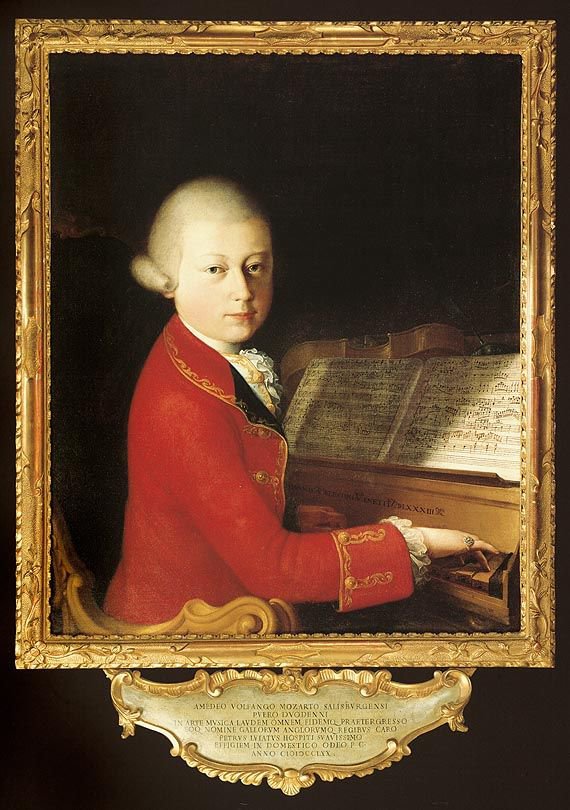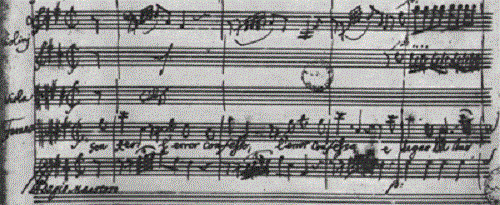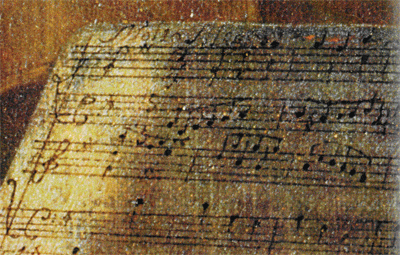
Giambettino Cignaroli or Saverio dalla Rosa (or possibly both in collaboration), Portrait of Wolfgang Amadeus Mozart, oil on canvas executed at Verona on 6-7 January 1770, possibly with later additions. Source: privately owned.
The origin and execution of this portrait—commissioned by Pietro Lugiati—is partly described by Leopold Mozart in a letter to his wife, written at Verona on 7 January 1770. It is also mentioned in a review dated 9 January of Mozart’s Verona concert of 5 January, published in the Gazzetta di Mantova for 12 January: ‘. . . on this and other occasions, subject to the most arduous trials, he overcame them all with an inexpressible skill, and thus to universal admiration, especially among music lovers; among them were the Signori Lugiati who, after enjoying and allowing others to enjoy yet finer proofs of this youth’s ability, in the end wished to have him painted from life for a lasting memorial.' Lugiati describes the importance of the picture to him in a letter to Mozart's mother dated 22 April of that year:
Since the beginning of the present year this our city has been admiring the most highly prized person of Signor Amadeo Volfango Mozart, your son, who may be said to be a miracle of nature in music, since Art could not so soon have performed her mission through him, were it not that she had taken his tender age into account.
I was certainly among his admirers, although, however much pleasure I have always taken in music and much as I have heard of it on my travels, I cannot hope to be an infallible judge of it; but I have certainly not been mistaken in the case of so amazing a boy, and I have conceived such a regard for him that I had him painted from life. . . This charming likeness of him is my solace, and serves moreover as incitement to return to his music now and again. . .
The history of the portrait after Lugiati’s death in 1788 is unclear. Bauer-Deutsch (Mozart. Briefe und Aufzeichnungen, iv.224) includes it among the portraits referred to by Constanze Mozart in a letter to Breitkopf & Härtel of 30 January 1799 — ‘I am aware of the existence of two portraits of my late husband done en face. . .’ — although there is no evidence to support this supposition; the fact that the picture apparently remained in private ownership in Verona and was unknown for nearly eighty years before it was first publicized[1] also speaks against it.
The identity of the artist is uncertain. It was traditionally thought to have been executed by Giambettino Cignaroli (1706-1770), the most important painter in eighteenth-century Verona,[2] chiefly because he is the only painter mentioned in Leopold’s travel notes from Verona: ‘Sgr: Cignarolli Pittore’. Rafaello Brenzoni, however, suggested it may have been executed by Cignaroli’s nephew Saverio Dalla Rosa (1745-1821), not only for stylistic reasons, but also because the detailed worklist of Cignaroli paintings included in Ippolito Bevilacqua’s Memorie della vita di Giambettino Cignaroli, which specifically included 5 pictures owned by Lugiati, does not mention it.
The instrument shown in the picture is a single manual keyboard by Giovanni Celestini (fl 1587-1610), a Venetian keyboard builder of the sixteenth century (the inscription reads ‘Joannis Celestini Veneti MDLXIII’); presumably it was among the instruments at the Lugiati household[3] although it is probably not the instrument for which the music on the music stand — the Molto Allegro K72a — was written. Daniel Heartz notes that the instrument’s range seems to extend only to a high C (at least as it is depicted in the portrait), whereas the Molto Allegro extends to C-sharp and D.[4] It is unclear who the composer of the work is: the manuscript as shown includes no attribution. This was not an issue for early scholars: Sonnleither and Vogel note only the presence of a piece of music on the stand, without considering who may have composed it, while Wurzbach does not mention it at all; Jahn says only the the piece ‘must have possessed some peculiar interest for the Veronese.’[5] Alfred Einstein was the first to claim the work for Mozart, in his 1937 revision of the Köchel catalogue.
Einstein’s attribution was taken over by Deutsch[6] but not by later scholars, at least not universally. Heartz was the first to suggest the work may not be by Mozart but by someone else, and in this he was largely followed by Wolfgang Plath, who edited the work for the Neue Mozart-Ausgabe.[7] According to Heartz and Plath, the style of the work depicted is atypical of the composer; Heartz suggested that it may be by Baldassare Galuppi.[8]
Two features of the painting suggest a closer relationship between the Molto Allegro and Mozart. One is that the painter was careful to include a legible version of the entire piece even though the right hand side of the manuscript is cut off by the edge of the picture and the frame; where ‘in reality’ some of the music should be lost, in the portrait it has been carefully tailored to fit the visible space with no loss of text
Further, the handwriting is atypical for Italy at the time and more closely approximates Mozart’s own musical handwriting. Possibly this also explains why no autograph for K72a survives: presumably such detailed work could not have been completed during Mozart’s two relatively brief sittings on 6 and 7 January and the manuscript was left behind as an artist’s model. This would not have been the first time the Mozarts had left behind a musical autograph, or given it to a patron: in London, Leopold presented the autograph of the motet ‘God is our Refuge’, K20, to the British Museum.

W. A. Mozart, Mitridate, authentic copy by an Italian copyist, Milan 1770-1771 (Lisbon, Biblioteca de Ajuda)

W. A. Mozart, Mitridate nr. 16, autograph score (string and vocal parts only), Italy 1770 (Paris, Bibliotheque nationale)

Verona portrait (detail)
Clues to the apparent authourship of K72a notwithstanding, there is no unequivocal evidence that the piece is in fact by Mozart, even if the portrait does depict a Mozart autograph; on other occasions Mozart copied out works by other composers without signing their names to his manuscripts, including the Psalm ‘De profundis clamavi’ K93 (K6 Anh. A22), by Georg Reutter, and the Missa super cantum gregorianum K44 (K6 73u), by Johann Stadlmayr, among others.[9]
The inscription on the painting is by the Veronese poet and scholar Giuseppe Torelli (1721-1781), a great nephew of the composer Giuseppe Torelli (1658-1709):
- AMEDEO VOLFANGO MOZARTO SALISBVRGENSI
- PVERO DVODENNI
- IN ARTE MVSICA LAVDEM OMNEM FINDEMQ. PRAETERGRESSO
- EOQ. NOMINE GALLORVM ANGLORUMQ. REGIBVS CARO
- PETRVS LVIATVS HOSPITI SVAVISSIMO
- EFFIGIEM IN DOMESTICO ODEO P[ONENDAM] C[RAVIT]
- ANNO MDCCLXX[10]
This portrait is also included in the Mozart Portraits theme.
[1] Sonnleithner, ‘Ein neu aufgefundenes Originalportrait Mozart’s’, 82-3.
[2] Concerning Cignaroli, see Bevilacqua, Memorie della vita di Giambettino Cignaroli eccellente dipinto veronese and Biadego, Di Giambettino Cignaroli pittore veronese: Notizie e documenti.
[3] For Celestini, see Wraight, ‘Two Harpsichords by Giovanni Celestini’; Pilipczuk, ‘Zur Geschichte des fast 400 jährigen Celestini-Cembalos im Museum für Kunst und Gewerbe Hamburg’; Beurmann and Pilipczuk, ‘Eine Rarität der Cembalobaukunst: das Virginal des Venetianers Celestini von 1594’; and Chinnery, ‘A Celestini harpsichord rediscovered’.
[4] Heartz, The Verona Portrait of Mozart and the Molto Allegro in G (KV 72a), 12.
[5] Sonnleithner, ‘Ein neu aufgefundenes Originalportrait Mozart’s’; Wurzbach, Mozart-Buch, 182; Vogel, ‘Mozart-Portraits’, 20; and Jahn, Life of Mozart, iii.412.
[6] Deutsch, Mozart und seine Welt in zeitgenössischen Bildern, 298.
[7] Plath, NMA IX/27/2: Einzelstücke für Klavier, xxviii-xxix.
[8] Heartz, The Verona Portrait, 16-17.
[9] See Pfannhauser, ‘Mozart hat kopiert!’ and Hintermaier, ‘Zur Urheberschaft des Introitus "Cibavit eos" KV 44 (73u). Mozarts mißglückter Transkriptionsversuch einer mensural notierten Musik’
[10] For Amadeus Wolfang Mozart from Salzburg / a young boy of twelve years [sic] / for whose music no praise can do justice / and therefore was honoured by the rulers of France and England / Pietro Lugiati had a portrait painted / of this most charming guest in his house / in the year 1770.
- Bibliographic Reference
- Vogel, ‘Mozart-Portraits’; Deutsch, 'Mozart Portraits'; Heartz, The Verona Portrait of Mozart and the Molto Allegro in G (KV 72a); Botteri Ottaviani, 'In posa a Verona. Due rittrati di Giambettino e Giandomenico Cignaroli'; Botteri, 'Ritratto di Wolfgang Amadeus Mozart 1769-1770: Giambettino Cignaroli? (Verona 1706-1770)'; Eisen, 'Notes on the Verona portrait of Mozart and the Molto Allegro K72a'